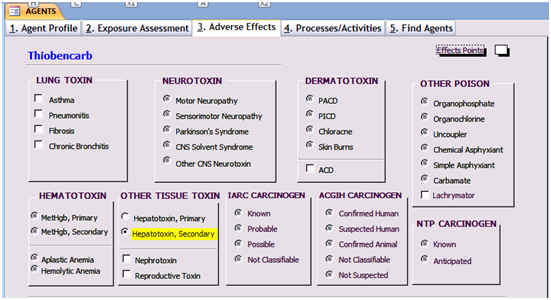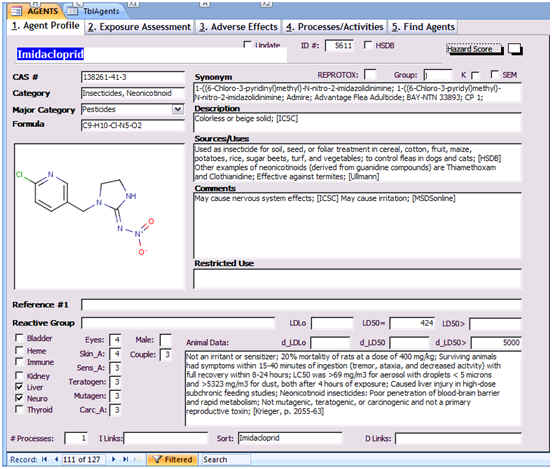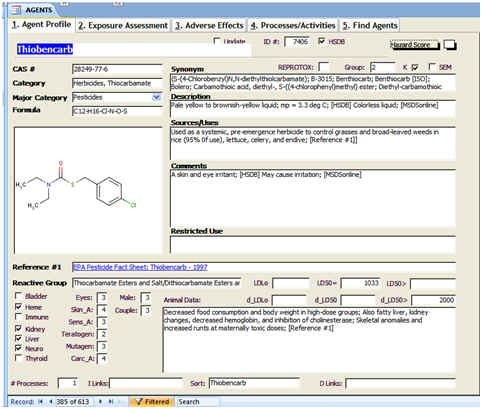Animal Data Fields
The animal data is becoming more robust--the studies are becoming more well defined, comprehensive, and reproducible. There must be thousands of scientists in the world in EPA, EU, WHO and other organizations working to identify which chemicals are toxic and exactly how they are toxic as shown by controlled animal experiments. Also, the results of these studies are being published on the Internet with very readable tables, summaries, and conclusions.
To get a better idea of what I'm talking about, you might take a look at a few of the new profiles. See http://www.epa.gov/oppsrrd1/reregistration/status.htm and http://dar.efsa.europa.eu/dar-web/provision. A lot of the documents have been published since 2000, and some of the longer ones are more than 200 pages.
So, what should Haz-Map do to respond to this growing improvement of animal data? I think it is better to try to distill these reports and capture some of the main facts into Haz-Map. For many of these chemicals, there is little or no epidemiology data. Most of the important epidemiology data comes from workers working in past decades. Now, with OSHA and EPA doing their work since 1970, workers are not as likely to be exposed to high enough concentrations to cause occupational diseases. We are left with the animal data to guide us in what are the possible health effects for humans. This is especially true when considering the chemicals that are left to be profiled. I have already completed profiles for the chemicals that are well known from epidemiology studies and workplace case reports. Those chemicals are already in Haz-Map. We are now adding many chemicals that are not mentioned in occupational medicine textbooks.The data fields I have started to use this week are preliminary, and there will changes to them as I work on the profiles during the next few months.
|
Eyes |
1= Corrosive (not
reversed in 3-7 days); 2 = Corneal opacity
(reversed in 3-7 days); 3= Irritation (reversed
in 3-7 days); 4
= No irritation; [Hayes, p. 732] |
|
Skin |
1= Corrosive; 2 = Severe irritation @
72 h; 3 = Mild-Mod irritation @
72 h; 4 = No irritation @ 72 h;
[Hayes, p. 732] |
|
Sensitizer |
1 = Strong (>30%
response with adjuvant or >15% without adjuvant); 2 = Weak; 3 = Negative; 4 = Unclassifiable
[Hayes, p. 1371; ICSC Compiler's Guide] |
|
Teratogen |
1 = Teratogenic @ <maternotoxic
dose; 2 = Teratogenic @ >maternotoxic
dose; 3 = Not teratogenic; 4 = Not classifiable;
(Hayes, p. 75) |
|
Mutagen |
1 = Probable human
mutagen; 2 = Possible human
mutagen (limited animal evidence); 3 = Not mutagenic; 4
= Not classifiable; (Hayes, p. 1193) |
|
Carcinogen |
1 = Likely human
carcinogen; 2 = Possible
human carcinogen (limited animal evidence); 3 = Not likely
(sufficient negative animal evidence); 4 = Unclassifiable;
[Luttrell, p. 170; Hayes, p. 732] |
Reproductive Toxin |
1 = Reproductive toxin @ <maternotoxic
dose; 2 = Reproductive toxin @ >maternotoxic
dose; 3 = Not reproductive
toxin; 4 = Not classifiable;
(Hayes, p. 75) (Female infertility, absence of pregnancies, increased time to pregnancy, or lower birth rate;)
|
|
Male Infertility |
1 = Probable (Sufficient
evidence); 2 = Possible
(Insufficient evidence); 3 = No infertility or
subfertility; 4 = Unclassifiable (Main endpoints are sperm
number, morphology, and motility;) |

"A distinction is made between toxicity and hazard. An extremely toxic chemical that is in a sealed container on a shelf has inherent toxicity but presents little or no hazard. When the chemical is removed from the shelf and used by a worker in a closed space and without appropriate protection, the hazard becomes great. Thus the manner of use affects how hazardous the substance will be in the workplace." [Rosenberg J, Israel LM. Clinical Toxicology. In: LaDou, p. 175]
"The mere presence of a particular hazard in an environment does not indicate that human exposure has occurred, nor does it provide an adequate basis for determining potential risk. The exposure potential must be assessed for an individual or group to determine the actual risk. . . . Hazard evaluation involves both the toxicity of the chemical or material and the opportunity for exposure to cause disease." [Van Ert MD, Crutchfield CD, Sullivan JB. Principles of Environmental and Occupational Hazard Assessment. In: Sullivan , p. 32]

[Home]
Revised: May 30, 2018
